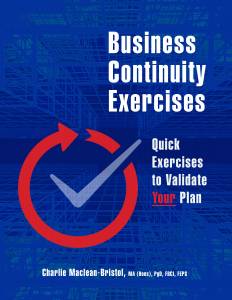The Importance of Incident Response Training for First Responders
Charlie Maclean-Bristol, FBCI FEPS discusses why incident responders are important to have within your company and the benefits of training them to a high standard
This week, I traveled down to the Midlands for my first onsite visit in 16 months. I have been preparing a training course for a manufacturing company, they wanted incident management training for their shift leaders. I thought this week I would share all the ideas and thoughts I had while developing a training programme for them. I call it Incident Response Training guide for first responders.
The dictionary definition of first responders is “a person whose job entails being the first on the scene of an emergency such as a firefighter or police officer.” When I am using this term, I am expanding it to include those from the organisation who should be at the scene of an incident and are expected to respond to the incident. This role could be enacting a contingency plan such as the fire evacuation procedure or it could be when the person or team is expected to respond to an incident such as a chemical spill
Importance of First Responders
I sometimes think when we are developing plans or conducting training and exercises that the activities of first responders, those who are going to respond immediately to an incident, are often neglected. We see an incident response as a senior management or middle management role. We forget that most incidents are dealt with and responded to by those who are actually at the site of the incident. If the initial response is well-managed, this can significantly influence the course of an incident.
The benefits of a well-managed initial response are:
- The response might be the difference between life and death for those immediately impacted by the incident.
- A good initial response may stop the incident before it escalates and becomes a major incident.
- The incident could be contained on-site before it affects those outside, which would prevent an increase in its visibility and the impact on those outside the organisation.
- A well-managed response can set the tone for later management of the incident. Suppose the incident is poorly managed from the beginning/ In that case those affected by it may lose confidence in the organisation’s ability to effectively manage this type of incident in the future.
Response Planning Requirements
Three elements must be prepared for the first responders to ensure they are ready to respond to an incident on their site
1. Identify the hazards and develop plans – The hazards on-site need to be identified and then contingency plans or procedures can be developed to respond to them. For example, for an office-based company the contingency plans could be for a fire, power cut or if the water supply to the building is lost. In manufacturing, the hazards could be a road accident, an injury caused by the machinery, a chemical spill or an explosion. Each of these hazards should be identified in advance and then an appropriate contingency plan can be developed. Sometimes these plans could just be evacuating the area and waiting for a specialist company or the emergency services to respond. Others may involve employees with the appropriate equipment and training responding themselves.
Whether the employees are going to manage the incident themselves or they are going to evacuate the area and wait for specialist support, a plan should still be written for this, and staff should be trained to carry out the plan. The training is essential to ensure that they have the knowledge the correct equipment and how to use it. For me, this training should be done by specialists in the subject especially when dealing with hazardous materials.
2. Develop tools, skills and confidence – There will be instances where an incident hasn’t been identified as part of the risk assessment and there’s no contingency plan in place. There will also be situations where the identified hazard may not play out as the writer of the contingency plan thought. The chemical spill could involve a casualty at the same time or could occur at the site gatehouse, not actually in the factory. A crucial part of first responder training is giving those responders the skills, tools, and confidence to manage a situation even when there isn’t a set contingency plan for the scenario. The training we will develop for the manufacturing company will involve classroom training to give them the tools needed for an incident response. We will also conduct practical exercises on several different scenarios where they will be expected to react and manage the scene. Finally, develop a number of simple tools and a checklist they can follow to help them manage the incident and respond appropriately.
3. Connect with business continuity and site emergency plans – The actions of first responders need to lead to a more comprehensive site plan, so that the consequences of the incident can be managed. I have often seen a disconnect between those in charge of health and safety who write the first responder plans, and the business continuity or resilience manager, who put together the overall site and organisation response plans. They are often uncoordinated and don’t flow together very well.
If you read military history, very often battles are won or lost based on the actions of a small number of individuals, often at a low level of seniority. Their actions or example can turn the tide of the battle and lead to victory. In the same way, in our organisation, the first responders set the tone for the rest of the response and may prevent the incident from escalating. Often, they do this without professional support from emergency services or the rest of the organisation’s resources. If we want to give ourselves the best chance of successfully managing an incident, we should not neglect these first responders, and make sure they have the skills knowledge and tools to respond.
This article was originally published by BC Training Ltd.
Charlie Maclean-Bristol is the author of the new book, Business Continuity Exercises: Quick Exercises to Validate Your Plan
 “Charlie drives home the importance of continuing to identify lessons from real-life incidents and crises, but more importantly how to learn the lessons and bring them into our plans. Running an exercise, no matter how simple, is always an opportunity to learn.” – Deborah Higgins, Head of Cabinet Office, Emergency Planning College, United Kingdom
“Charlie drives home the importance of continuing to identify lessons from real-life incidents and crises, but more importantly how to learn the lessons and bring them into our plans. Running an exercise, no matter how simple, is always an opportunity to learn.” – Deborah Higgins, Head of Cabinet Office, Emergency Planning College, United Kingdom
Click here for your FREE business continuity exercises!
“Overall a very interesting & informative, sometimes funny and in-depth publication that will be of great use to a wide audience worldwide I am sure, including me.” – Tim Marjuson, BCM & Crisis Management Consultant and Instructor, Dubai
“Charlie’s new book is a real tour de force of how to exercise Business Continuity Plans and Programs. As a former consultant, I immediately recognized many of the difficulties and pitfalls he has identified. One is the perennial problem of getting buy-in or even interest from senior management. Another is trying to do too much in a single exercise which requires a large number of participants, excessive time commitments from busy managers, complex scenario-building and often difficulty in creating enough challenges to engage non-core attendees. The book neatly deals with many of these issues. I really liked the concept of speed exercising and I can envisage it being both fun and informative.” – Lyndon Bird, Chief Knowledge Officer, DRI International
“Business Continuity Exercising has never received the attention it truly deserves, until now. Charlie’s experience in this area shines through in this volume. Applicable to the novice or the seasoned professional, this book is a welcome addition to the Business Continuity industry. Charlie takes the reader from the basics through to the planning and carrying out of an exercise, which is extremely valuable. Even though I’ve over twenty years’ experience in this area, it helped me to think about areas of Business Continuity I hadn’t considered for some time. The structure of the book, going from planning through to conducting the exercises is well thought out and packed full of useful ideas, with templates and examples throughout the book. It’s a book I would happily recommend for the content, style and detail.” – Gary Hibberd, Professor, Cyberfort Group, UK

